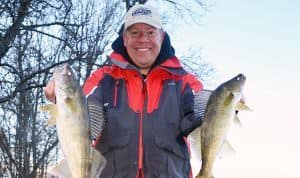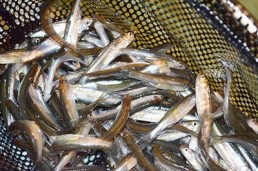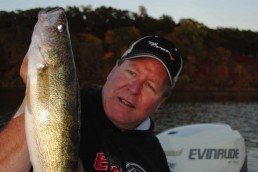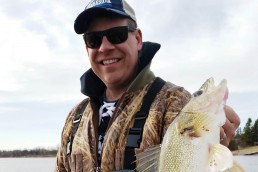Follow Fall Emerald Shiners to Fat Rainy River Walleyes
SHARE THIS POST
As the air begins to cool and the leaves begin to float to the ground, an annual event of nature takes place within one of North America’s premiere walleye fisheries. Each fall, large numbers of emerald shiners make their way from Lake of the Woods into the Rainy River. The shiners are headed upstream, leading to some of the hottest and most enjoyable walleye action of the year.
Every year is different when it comes to how robust the run is.
“We don’t know for sure why the emerald shiners run in the fall, but one thing we do know is fish don’t expend energy for no reason,” says Phil Talmage of the Minnesota DNR Fisheries in Baudette, Minn., on the emerald shiner run. “We think they may be attracted into the river by a favorable food source or perhaps a difference in water temperature. We also do not know the effects an invasive species, the spiny water flea, has on the emerald shiners’ behavior.”
It seems the run can be triggered by weather, flow of the river, length of days, water temperatures, and, most likely, a myriad of things only the shiners know. Some years the shiners run so thick it looks like you could walk on them—this is when you hear splashing fish busting up through the schools of minnows; other years, the run of shiners is tame. Either way, the local walleyes that live in the river, or ones that come out of the lake and enter the river to feed on the shiners, lead to great fall fishing.
Emeralds harvested for bait
The fall shiner run is also an important time of the year for local, licensed bait dealers. With the popularity and success of emeralds for anglers fishing Lake of the Woods, bait dealers are hoping for a robust run and are busy working to net the shiners. Their inventory helps successful fall netting, providing anglers with a supply of frozen shiners through the year until next fall. If they don’t get the shiners now, they are out of inventory and risk missing out on sales to anglers who realize the allure emeralds have to walleyes.
Bait dealers have their favorite spots to net emeralds and acquiring the right spot can be difficult. Typically, the dealers will use a large light just above the water with a lift net underneath the water about 2 to 3 feet. When the shiners are running, they will be attracted by the light and swim in a circle just below the surface and just above the submerged net. The bait dealer then pulls down on a rope connected to the net by a pulley lifting the net above the water. If everything goes well, there could be more than a couple of gallons of shiners in a single lift.
Timing is everything
This time of year is not for sleep for bait dealers. The best runs of emeralds happen during darkness. This might mean checking the run two or three times throughout the night. Sometimes there is nothing; other times it might be filling the minnow tanks.
Once the shiners are harvested, the decision is made to sell them as live bait or begin the process of properly freezing them. Shiners are not the heartiest of minnows to keep alive, so bait dealers do pay attention to the details. Some keep a live bait livewell in the river. Others have big minnow tanks kept at a certain temperature of water while robust water pumps keep the water well oxygenated.

Anglers benefit from purchasing live emeralds—and keeping them alive. Filling your minnow bucket with cold water from the bait shop helps. Some anglers use a portable aeration system installed on the minnow bucket. Others will use a flow troll bucket and get the minnows into cold river or lake water as soon as possible. One resort actually sells emeralds with the minnows already in small Styrofoam buckets that they keep cold in a refrigerator.
When it comes to freezing emeralds, every bait dealer has their special recipe and method. Some simply package and freeze the shiners. Others really have it down to a science: One local bait dealer pours pickling salt into a 5-gallon pail of water mixed with shiners just prior to freezing. This particular bait dealer believes this helps the longevity and quality of the bait. He believes these will last a few years prepared this way, verses only nine months if not salted and frozen properly.
Are you enjoying this post?
You can be among the first to get the latest info on where to go, what to use and how to use it!
The walleyes are close behind
There are a number of methods to catch walleyes that are chasing the shiners, but the most common is a jig and minnow. Anchoring up on the edge of structure or a current seam, and vertically jigging while watching the migration of waterfowl, is a great way to spend a fall day. Some anglers use fatheads or rainbows on their jigs. Others prefer a live emerald shiner if available. Another great choice for anglers wanting to match the run is a frozen emerald shiner.
One of the nuances I have incorporated while jigging fall walleyes on the Rainy River is a stinger hook. Two things amaze me: First, is how many more fish I catch with a stinger. In some cases, the stinger may detract from some of the action of the minnow, but remember, the water in these parts is stained due to the tannins from the watershed. I believe that makes the walleyes a bit more forgiving (this is also why anglers can do their fishing during daylight hours rather than focusing on low light or darkness).
Another thing that has surprised me is how big of fish that little stinger hook will catch. It is nerve- racking to see a nice walleye shaking its head with a very small treble in its lip, but most of the time those fish make it to the net. Stinger hooks have improved my catch rate of fall walleyes.
Trolling fall walleyes
Some anglers go to the method of trolling, often with crankbaits matching the shiners. Walleyes are opportunists and are always on the lookout for that one injured minnow in the school. A good crankbait will imitate that injured minnow, creating reaction strikes and allowing an angler to cover water until they find fish.
One sunny, fall afternoon I was anchored and jigging on the Rainy River, and had the chance to have some chitchat with passing anglers trolling by. They were in a big Ranger boat that had “Iowa” tags on it.
“You can’t troll for walleyes this time of year…The water is too cold!” I said, kiddingly.
“Tell the three walleyes over 28 inches and the many others we caught today that,” they replied with a smile. “We look forward to this trip every fall.”
Obviously, the walleyes are still chasing and eating minnows when the water cools, and crankbaits can be very effective.
If you are after the many walleyes in the Rainy River this fall, or simply purchasing some shiners for your next fishing adventure on Lake of the Woods, there is quite a story behind it all. Chances are that the emerald shiners you are using once swam up the Rainy River in the fall, and were attracted by a bright light in the darkest of nights caught by a local bait dealer who is lacking sleep. That dealer became part of a well-thought out process of packaging bait, enabling all of us to experience the adrenaline rush of hooking a nice walleye—one that sill burns in our minds with great memories for many years to come.
MWO
SHARE THIS POST
Did you enjoy this post?
You can be among the first to get the latest info on where to go, what to use and how to use it!
Joe Henry
Tournament angler and licensed charter captain Joe Henry fishes and hunts the Midwest. Henry is a media member of AGLOW and writes for numerous publications, creates videos, appears on a variety of outdoor TV and radio shows and is a frequent seminar speaker. Henry is the Executive Director of Lake of the Woods Tourism.




Which fall trolling lures (and sizes) do you recommend for walleyes on the Winnipeg River up in Minaki next week?
Jim,
I’ve forwarded your email onto our editors and will provide an answer for you once I hear back.
Thank you
Dena Gervasi
Managing Editor